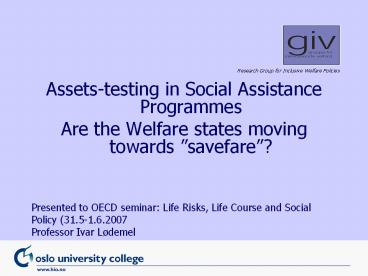Assets-testing in Social Assistance Programmes - PowerPoint PPT Presentation
1 / 14
Title:
Assets-testing in Social Assistance Programmes
Description:
Assets-testing in Social Assistance Programmes Are the Welfare states moving towards savefare ? Presented to OECD seminar: Life Risks, Life Course and Social – PowerPoint PPT presentation
Number of Views:39
Avg rating:3.0/5.0
Title: Assets-testing in Social Assistance Programmes
1
- Assets-testing in Social Assistance Programmes
- Are the Welfare states moving towards savefare?
- Presented to OECD seminar Life Risks, Life
Course and Social - Policy (31.5-1.6.2007
- Professor Ivar Lødemel
2
- And your mom was saving money for you in a jar.
Tried to start a piggybank for you so that you
could go to college. Almost had a thousand
dollars, until someone broke in and stole it. And
I know it hurt so bad it broke your mammas
heart. - From the song Mockingbird by Eminem
3
Outline
- Present the main terms and issues
- The role of assets testing in the Welfare State
- Outline possible effects on saving behaviour
- Tentative comparison of means testing in a select
number of OECD Member Countries, including
changes in the 1994-2006 period - Discuss the extent to which changes are related
to an increased emphasis on the need to promote
saving - Speculation about future scenario
4
Key terms and concepts
- Social assistance
- Institutions of curtailment
- Work house test (today ideal type workfare?)
- Less elibility (today low benefits and strict
means test) - Means test
- Earnings and other income (such as Child Benefit)
- Assets
5
Why focus on social assistance
- Assets-based initiatives focus on the poor
- The means test if often stricter in social
assistance than in other means tested programmes - From life course perspective means testing in
social assistance has greater implications than
in for example old age pensions - Lack of comparative studies following great
changes in s.a. over the last decade
6
The means test in the Welfare State
- The hatred of the means test in the poor laws
facilitated transition to modern welfare states - Great variations in the use of means testing
across welfare states (Australia vs Nordic) - Highlights contradiction of the two aims of s.a.
- Makes sense in ensuring lowest safetynet function
- Resulting asset stripping in conflict with
help-towards-selfhelp
7
Arguments for means testing (in sa)
- Benefits targeted at poor are more effective in
closing poverty gaps than are universal
programmes - ..a comprehensive approach to poverty reduction
calls for a program of well targeted transfers
and safety nets.. (World Bank 1990) - OECD Jobs Study (1994)
- Dependency argument (Malthus and Murray) avoid
exposing people to welfare
8
Aguments against a strict means test
- Dependency (Mead) discourages thrift and self
help - Poverty traps (asset traps)
- Inability to save for a rainy day
- Intrusive enquiry and stigma
- Low take-up
- Social divisiveness
- Undermines social capital (Rothstein)
- High administrative costs
- Poor relief rather than furthering self-reliance
9
Review Tentqtive on effects of assetstest on
saving
- Review of (some) 30 studies
- Majority of studies conclude with negative effect
- Few studies comparing systems with different
assets test - US study 1995 found different saving in states
with different rules (Powers 1995/1998) - Vast majority of studies from the US
- Saving is more important than in Europe
- Much research closely related to ABW
- Lacking cross national comparison
10
Means testing in OECD Member Countries1994
(Eardley et al 1996)
- Strict Austria, Switzerland, Norway, Sweden,
Japan - Less strict English speaking countries
- Eardley An unlikely mix of countries
11
Changes in allowable incomefrom earnings and in
assets 1994-present
- Canada (Ontario)
- Earnings from CD 143,- plus 25 of above to 50
of all earnings (2006) - Assets Car, savings for childrens education
(RESP) - USA
- Earnings Exemptions remain low (up to poverty
level) - Assets Connecticut eliminated assets test for
families with children. In general exemptions of
USD 1-2000,- - UK
- Earnings still low disregards
- Assets exemption was unchanged 1994-2006, now
doubled to pounds 6000,-
12
Changes in other nations (examples)
- Denmark Earnings disregard for recipients on
activation - Finland 20 of earnings (up to Euro 150)
disregarded - Norway Increased earnings disregard for people
on activation
13
Tentative asessment of changes
- Observed changes mainly related to earnings
- This corresponds with emphasis on activation and
transition to work - Less change with regard to assets
- More nations disregard child benefits (child
poverty) - No evidence to suggest that the growing interest
in assets-based welfare has resulted in greater
changes in ABW-nations (possible exception
Canada)
14
DiscussionSavefare as 3rd generation activation?
- Activation generic for ALMP for the poor..
- Workfare An offer you cant refuse
- Trainfare An offer.. (u shouldnt ref..)
- Savefare An offer (that seems to good to
refuse?) - Elements of what may become savefare
- Assets-based programmes for s.a. recipients
- Assets exemption only for participants
- Determines use of saved assets (paternalistic)
- Compulsory training for those accepting offer
- Danger (as with workfare) lots of claims about
great effects, strong moral (under-)tones in
advocacy/debate































